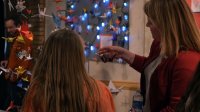Creating Academic Exhibits
A museum magnet school uses student-created interdisciplinary exhibits to assess learning.
Overview
Creating a Museum of Student Work
As a museum school, Normal Park utilizes student-created exhibits as a way to assess student learning. Every nine weeks, the entire school turns into a museum where student work is on display and the learning students have done over the past quarter is celebrated. Exhibits are a great way for students to take ownership of their learning.
Exhibit pieces include art projects, essays, poems, travel journals, sculptures, and drawings. Each exhibit piece is accompanied by a student-written exhibit label, which describes the piece, its academic content, and the student’s personal connection to the work.
Teachers use the exhibits and exhibit labels as one of the key assessments of student learning.
How It's Done
Designing Exhibits to Demonstrate Learning
Normal Park divides its year into four nine-week quarters. Each quarter, every student studies either a science- or social-studies-themed module. Students may create several exhibit pieces per module; exhibits must include contributions from each of the core subject areas: language arts, reading, math, and science or social studies plus the related arts teams (art, foreign languages, and library).
Here are the steps teachers and students take to create academic exhibits:
- Prior to the start of each quarter, teachers sit down and look at the standards connected to that module. Using a backward-design approach, teachers at each grade level figure out the big ideas that students need to learn that quarter. These are put into question format, for example, “How does structure affect behavior?” or “How does where you live affect how you live?” These Essential Questions are the basis for every lesson that’s taught in the module and the questions that students answer in their exhibit work.
- Teachers think about what exhibit pieces can demonstrate student understanding of the material and talk with students about possible approaches. Exhibit pieces can include drawings, sculptures, writing, science projects, visual art, audio recordings, and many other types of projects.
- Students work on their exhibit pieces throughout the quarter. Exhibit pieces will vary in terms of intensity and sophistication from grade level to grade level. As students get older, they become much more independent with their exhibits, and teachers develop rubrics to go along with a particular assignment. Toward the end of the module, students write exhibit labels for each of their pieces. Modeled on the labels typically found in museums, exhibit labels show students’ best understanding of an Essential Question. Exhibit labels should demonstrate the use of academic vocabulary, a connection to the content, and a personal connection. A well-written exhibit label shows understanding at the highest level.
- During the ninth week of the module, teachers and students put up the exhibit work.
- After the exhibits go up, teachers have a faculty meeting to walk through all the exhibits and look for evidence of understanding. Each teacher will have a list of the expected understandings and the Essential Questions for that module and will identify the best examples of understanding. Faculty members then compare notes and share what they have identified, so all faculty members are on the same page about their expectations for exhibits and the demonstration of true understanding.
- The quarter culminates with Exhibit Night, during which selected pieces of student work are presented. Every student has two to four pieces in the exhibit. On a single night, hundreds of parents and family members come through the doors of the school. It is a big celebration of learning for everyone.
Normal Park Museum Magnet School
Enrollment
819 | Public, UrbanPer Pupil Expenditures
$9444 School • $9444 District • $9293 StateFree / Reduced Lunch
27%DEMOGRAPHICS:
4% English Language Learners
